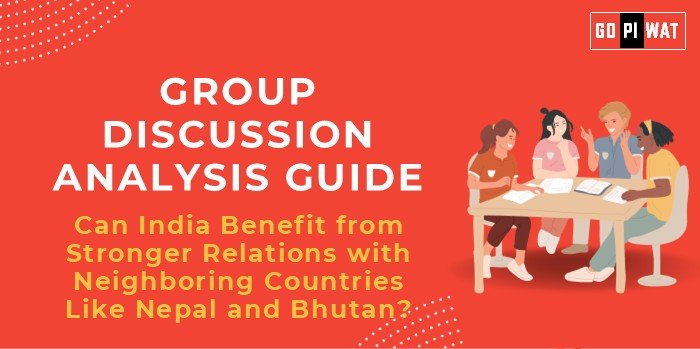📋 Group Discussion (GD) Analysis Guide
🌐 Topic: Can India Benefit from Stronger Relations with Neighboring Countries Like Nepal and Bhutan?
🌟 Introduction to the Topic
Opening Context: “India’s relations with its neighbors, especially smaller nations like Nepal and Bhutan, are pivotal in fostering regional stability and enhancing economic growth. These ties also influence India’s geopolitical standing.”
Topic Background: India shares deep historical, cultural, and economic ties with Nepal and Bhutan. While trade, water-sharing, and cultural exchanges are key aspects of these relationships, issues like border disputes and external influences challenge their dynamics.
📊 Quick Facts and Key Statistics
- 📈 Nepal-India Trade: $8 billion+ annually; Nepal heavily depends on India for trade.
- ⚡ Hydropower Collaboration: Bhutan exports 70% of its electricity to India, earning $150M+ annually.
- ✈️ Tourism: Over 1.5 million Indian tourists visit Nepal and Bhutan annually, boosting local economies.
- 🛡️ Strategic Importance: Bhutan and Nepal act as buffers between India and China, enhancing India’s security framework.
🤝 Stakeholders and Their Roles
- Indian Government: Implements foreign policy and developmental aid.
- Nepal and Bhutan Governments: Facilitate bilateral agreements and regional stability.
- Businesses: Enhance trade and investment, especially in hydropower and tourism.
- Citizens: Strengthen cultural and economic exchanges.
- Global Players (e.g., China): Compete for influence in the region, affecting India’s strategic interests.
🏆 Achievements and Challenges
🎯 Achievements:
- Hydropower success with Bhutan generates 2,200 MW+ energy.
- Projects like the Motihari-Amlekhgunj petroleum pipeline streamline Nepal’s fuel supply.
- Cultural diplomacy through Buddhist circuit projects enhances India’s soft power.
⚠️ Challenges:
- Border disputes, such as Kalapani with Nepal, strain trust.
- China’s growing influence in Nepal through the Belt and Road Initiative (BRI).
Global Comparisons: Bhutan’s hydro export model is often compared to Laos’s electricity exports to Thailand.
Case Studies:
- India-Bhutan Hydropower Model: A win-win for sustainable energy trade.
- Kalapani Border Dispute: Strains India-Nepal relations despite cultural ties.
📚 Structured Arguments for Discussion
- Supporting Stance: “Stronger ties will ensure economic interdependence and reduce China’s influence in the region.”
- Opposing Stance: “Unresolved border disputes and mistrust hinder the potential benefits of closer ties.”
- Balanced Perspective: “While stronger relations promise growth, addressing underlying issues is essential for long-term success.”
💡 Effective Discussion Approaches
🚀 Opening Approaches:
- Use statistics like India-Nepal trade value to highlight economic stakes.
- Reference hydropower as a success story for regional collaboration.
🛠️ Counter-Argument Handling:
- “While border disputes persist, mechanisms like the Eminent Persons’ Group aim to resolve them.”
- “China’s influence is undeniable, but India’s shared cultural history provides a unique edge.”
📈 Strategic Analysis of Strengths and Weaknesses
- Strengths: Strong cultural ties, economic interdependence, strategic location.
- Weaknesses: Border disputes, mistrust over aid dependency.
- Opportunities: Regional economic integration, renewable energy collaboration.
- Threats: External influence from China, unresolved historical issues.
🔗 Connecting with B-School Applications
-
Real-World Applications:
- Role of regional partnerships in international business and policy-making.
-
Sample Interview Questions:
- “How can India balance strategic interests with cultural diplomacy in the region?”
- “Discuss India’s hydropower strategy with Bhutan and its global implications.”
-
Insights for Students:
- Understanding regional collaborations is key for international business roles.
- Lessons in conflict resolution are vital for leadership development.


